Those of a certain age can remember watching the footage of the Apollo 11 moonwalk live on television: the view was grainy, shadowy, and dark but it was from the Moon, which trumped everything else. Two years ago for the 40th anniversary of Apollo 11, NASA digitized and re-mastered the original footage, cleaning it up significantly. Here’s a brief montage from all the film that was cleaned up, put together by the Bad Astronomer.
Through the Wormhole Episode: Can We Travel Faster Than Light?

[/caption]
Through the Wormhole with Morgan Freeman has entered into its second season and is working to highlight topics as physical as space flight and as metaphysical as whether or not we have a sixth sense. The show is hosted by Academy Award-winner Morgan Freeman and airs on Wednesday nights on the Science Channel. This week’s show deals with a subject that many space flight enthusiasts have wondered for some time – can we really travel faster than the speed of light?
If the universe has a speed limit – it is considered to be the speed of light – at least we think it is the limit. Ever since Albert Einstein introduced us to the Theory of Relativity – we have been seeking ways if not to break this limit – then at least to bend it – a lot. For according to Einstein – it is impossible for humans to go faster than light. Scientists working in laboratories across the globe are trying to prove Einstein wrong – but can they? Time will tell and Through the Wormhole will take a peek at their efforts.
The show tackling the question of light speed will air on Wednesday, July 20, 2011 at 10 p.m. EDT.
It turns out that Freeman himself has often pondered many of the questions raised on the show and he wanted to share his wonder with the rest of world.
“My love affair with science and the unknown began for me in my high school physics class,” said Freeman. “My mind sprung open – all because of the questions I asked. In this new season of Through the Wormhole, we will explore ten new mystifying questions that will change the way you look at the world around you.”
Morgan Freeman and Lori McCreary are executive producers for Revelations Entertainment which produces the show. As mentioned, the show is entering its second season; this was confirmed in February of this year. The show was conceived as utilizing an element of pop culture (in this case Morgan Freeman, a celebrity, as the show’s narrator) with deep questions that have confronted mankind, in some cases since the dawn of time. By all accounts the show has been very successful.
Atlantis Undocks from ISS; Farewell for Shuttle
The crew of STS-135 are now on the homestretch of their mission. At 2:28 a.m. EDT Tuesday, space shuttle Atlantis undocked from the International Space Station while the spacecraft were 243 miles above the Pacific. Atlantis spent eight days, 15 hours and 21 minutes docked to the ISS.
Atlantis is scheduled to make its first attempt to land at NASA’s Kennedy Space Center on Thursday, July 21, at 5:56 a.m. EDT.
Love of Science Drives Last Shuttle Commander – Chris Ferguson Brings Science Museum to Orbit
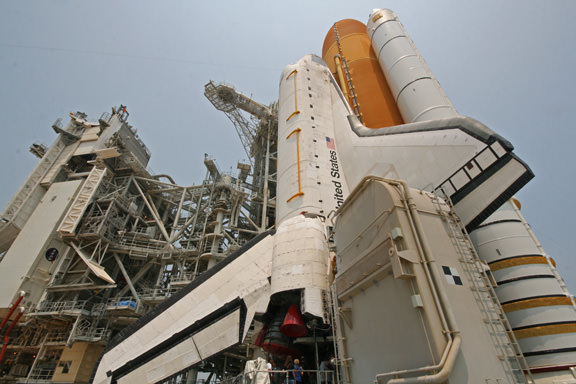
[/caption]
In the weeks leading up to the launch of Space Shuttle Atlantis, I had the distinct honor to speak on several occasions with Chris Ferguson, the Space Shuttle Commander of the STS-135 mission that will soon close out NASA’s Space Shuttle Era.
Chris talked to me about his childhood experiences that led him to “love science” and how he strongly believes in “giving back” to a community that enriched him so much – and eventually led him to his career as a space shuttle astronaut.
That passion for science and giving will result in an extraordinary and out of this world gift to the people of Philadelphia, Pennsylvania, hometown to Chris Ferguson that he hopes will inspire kids to love science.
I first met Chris about two years ago in Philadelphia when he generously gave a well received presentation to our astronomy club, the Rittenhouse Astronomical Society – which meets at the Franklin Institute Science Museum and where I frequently lecture too.
At that time Ferguson had already been a veteran space flyer with two trips to the International Space Station – but he not yet been named to command the last shuttle flight. Over 150 folks attended Ferguson’s talk – held in the presence of the marble statue of Benjamin Franklin. The statue is a US National Historic Landmark.
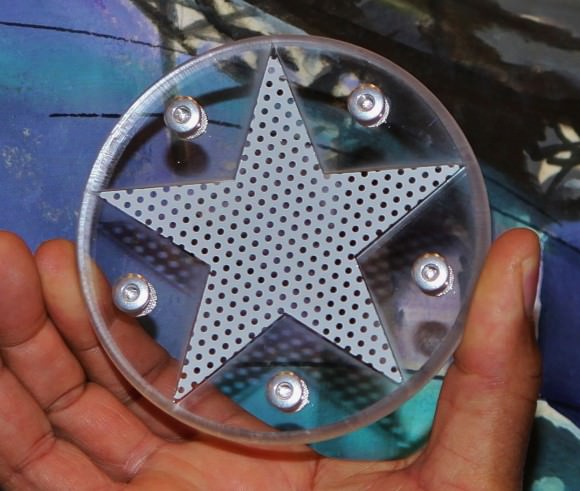
STS-135 Shuttle Commander Chris Ferguson seeks to inspire kids to study science as a way to give back to his hometown community which inspired him to accomplish great goals and become a space shuttle astronaut. Ferguson brought this small piece of the Franklin Institute to the space station and back. The 5-pointed 4-inch star from the Franklin Institute’s Fels Planetarium dome will be put on public display for the future enjoyment of millions of kids of all ages. Credit: The Franklin Institute Science Museum
As a child, Chris attended classes from grade school to high school in Philadelphia, the city of brotherly love.
“I developed and cultivated a love of science, engineering and space in many childhood trips to the Franklin Institute in Philadelphia,” Ferguson told me.
“I was always a science oriented kid growing up. I have an innate curiosity for how things work. The Franklin Institute fed my curiosity.”
“And it was some teachers I had at a young age in my high school in Philadelphia who made me want to understand more. And to understand the reason about why things work the way they do … And to understand why the physical laws that govern the Universe are the way they are.”
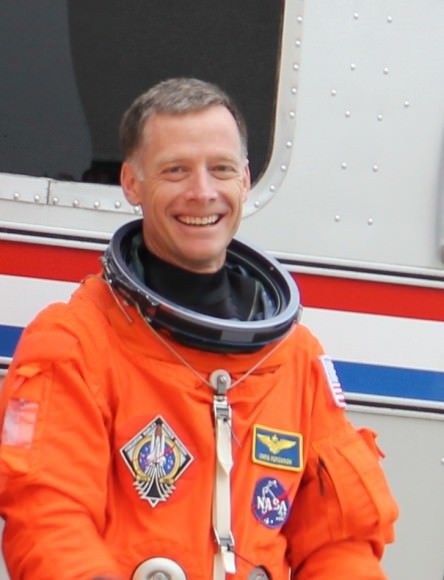
“The one thing I could never fathom well was understanding spaceflight. And the way to really understand something is to go do it,” said Chris Ferguson.
“What this is really about is going into space, living and working there and dragging the American public along with us. We need to constantly feed the machine for the folks who are curious and are on a quest to understand things they don’t understand and desire to wonder what’s beyond low Earth orbit and how you live in space for a long period of time.”
“The only way you feed that is by planting the seeds when they are young. You grow the big Oaks out of little acorns.”
“And you get the little acorns at places like the Franklin Institute and the Smithsonian National Air & Space Museum. That’s what did it for me,”
“I think you need to go back and you need to give back. So I’m looking forward to going back to the Franklin Institute !” said Ferguson
And when Chris does go back to the Franklin Institute later this year he will bring along a very very special gift – a piece of the Institute’s Fels Planetarium dome flew millions of miles to the space station and back aboard history’s very last Space Shuttle orbiter – Atlantis – that will ever take a star trek to the High Frontier.
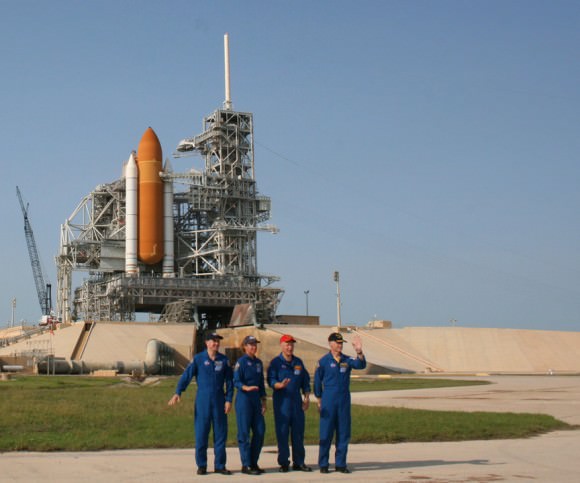
And the project was Ferguson’s idea according to Derrick Pitts, Chief Astronomer at the Fels Planetarium of the Franklin Institute.
“Chris sent me an email asking if we (The Franklin Institute) would like to fly something on STS-135,” Pitts told me.
“I quickly agreed, found out what the criteria for launch would be and then pulled a team together to figure out what to send. It was decided to send a star-shaped piece of the original Fels Planetarium dome.
“The original dome was replaced in 2002 but I’d kept several large sections of the stainless steel panels and had a number of 5-pointed stars about 4″ across cut from the panels to mount and give as gifts to friends of the Fels. It weighs about 6 oz.”
“Since more than 10 million visitors have sat under that dome including several school students who would later become NASA astronauts, it seemed fitting to send one of these stars.”
“The piece presented some problems though. As a stainless steel piece, it has sharp edges and 5 very sharp points – both verboten by NASA and it is ever so slightly oversized. We fixed the worst problem by encasing the star – points edges and all – in a transparent acrylic ‘jewel box’ sandwich held closed with stainless steel screws.”
“We had about ten days from the first email to delivery date to him in Houston. When it returns to Earth, Ferguson has offered to bring it back to Philadelphia where we’ll put it on permanent display in the main Planetarium hallway. This will be the second time Franklin has flown an article with a native Philadelphian astronaut. Our last trip was with Jim Bagian on STS-40 in 1991.”
Chris is a humble, eloquent and down to earth guy and knows how lucky he is to be commanding the grand finale of the thirty year long shuttle program. And he is determined that he and his STS-135 crew of four do their very best to accomplish all their goals.
“I’m just proud to be a small part of it and am savoring the moment. We’re focused on the mission now and will have time to ponder this moment in history when it’s all over,” Ferguson concluded.
Space Shuttle Atlantis and her crew of 4 are scheduled to land at 5:56 a.m. on July 21, 2011 at the Kennedy Space Center in Florida.
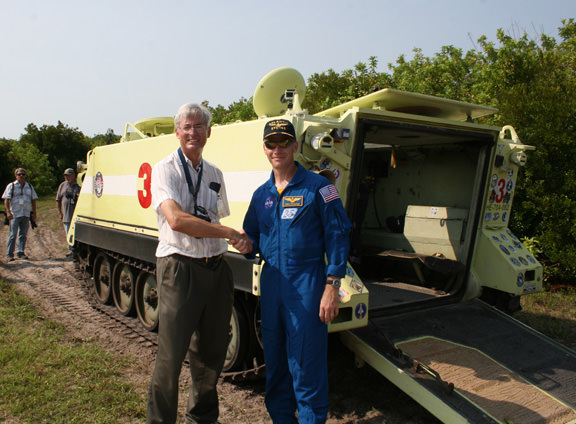
Read my features about the Final Shuttle mission, STS-135:
Revolutionary Robotic Refueling Experiment Opens New Research Avenues at Space Station
Water Cannon Salute trumpets recovery of Last Shuttle Solid Rocket Boosters – Photo Album
Shuttle Atlantis Soars to Space One Last time: Photo Album
Atlantis Unveiled for Historic Final Flight amidst Stormy Weather
Counting down to the Last Shuttle; Stormy weather projected
Atlantis Crew Jets to Florida on Independence Day for Final Shuttle Blastoff
NASA Sets July 8 for Mandatory Space Shuttle Grand Finale
Final Shuttle Voyagers Conduct Countdown Practice at Florida Launch Pad
Final Payload for Final Shuttle Flight Delivered to the Launch Pad
Last Ever Shuttle Journeys out to the Launch Pad; Photo Gallery
Atlantis Goes Vertical for the Last Time
Atlantis Rolls to Vehicle Assembly Building with Final Space Shuttle Crew for July 8 Blastoff</a
First Ever Vesta Vistas from Orbit – in 2D and 3D
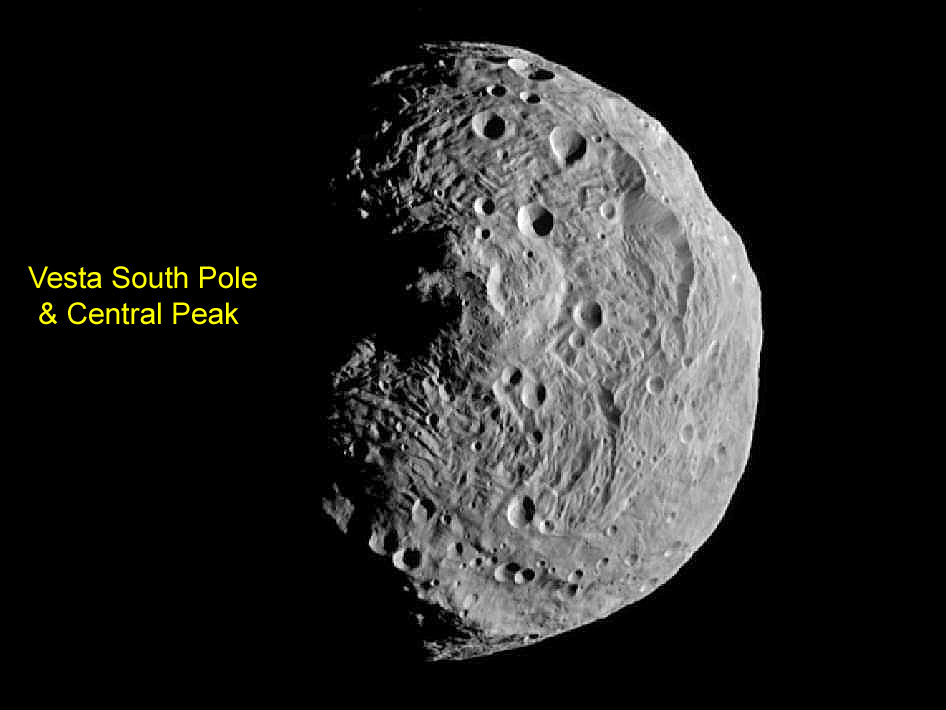
[/caption]
The first ever Vesta Vista snapped from the protoplanets orbit has been transmitted back through 117 million miles of space to eager eyes waiting on Earth. Although Vesta had been observed by telescopes on Earth and in space for more than two centuries since its discovery, only scant detail on its surface could be discerned until today.
NASA’s Dawn spacecraft took the new photo of the giant asteroid Vesta on July 17 – enhanced version shown above – less than 2 days after making space history as the first probe ever to enter orbit about an object in the main Asteroid Belt. The team also released their first 3 D image of Vesta. Read my orbital capture story here and see the original NASA image below.
“I think it is truly thrilling to be turning what was little more than a fuzzy blob for two centuries into a fascinating alien world,” said Dawn Chief Engineer Marc Rayman in a new post orbit interview with Universe Today.
Vesta is 330 miles (530 kilometers) in diameter and the second most massive object in the Asteroid Belt between Mars and Jupiter.
“And the closer Dawn gets to Vesta, the more exotic and intriguing the pictures become !,” added Rayman.
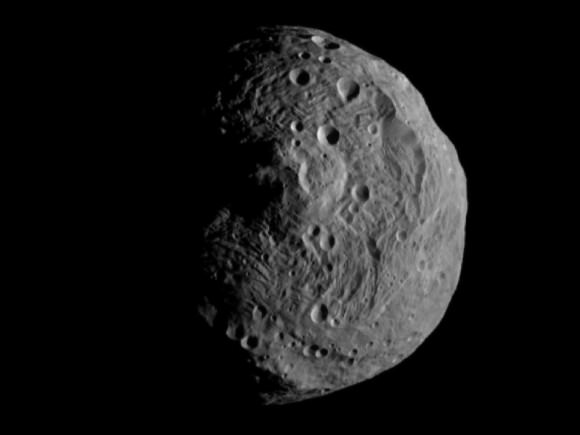
NASA's Dawn spacecraft obtained this image with its framing camera on July 17, 2011. It was taken from a distance of about 9,500 miles (15,000 kilometers) away from the protoplanet Vesta. Each pixel in the image corresponds to roughly 0.88 miles (1.4 kilometers). Credit: NASA/JPL-Caltech/UCLA/MPS/DLR/IDA
Enhanced image above
Dawn was captured into orbit at an altitude of 9,900 miles (16,000 km) at 1 a.m. EDT on July 16 according to Rayman, of the Jet Propulsion Lab in Pasadena, Calif. and is now slowly descending over the next few weeks.
“The spacecraft remains healthy, and our spiral down to Vesta is going well,” Rayman told me.
The new photo from orbit is nearly centered on the south pole which suffered a devastation cosmic collision eons ago. That blast sent huge plumes of ejecta streaming out, including towards Earth. About 5% of all known meteorites stem from Vesta.
“The south pole is a bulging feature in the images,” said Prof. Chris Russll, Dawn’s Science Principal Investigator of UCLA in an interview.
“The pole is not centered on this feature but is close to it. We have not finalized our determination of the pole but are close to a ‘final’ answer. We are not making interpretations at this point because the greater resolution that is coming will make all today’s speculations moot,” Russell stated.
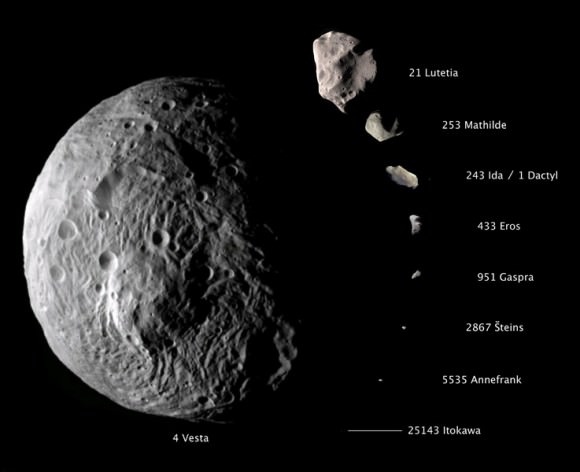
This composite image shows the comparative sizes of nine asteroids visited by Earthly spaceships. Up until now, Lutetia, with a diameter of 81 miles (130 kilometers), was the largest asteroid visited by a spacecraft, which occurred during a flyby. Vesta, which is also considered a protoplanet because it's a large body that almost became a planet, dwarfs all other small bodies in this image, with its diameter sizing up at approximately 330 miles (530 kilometers). Credit: NASA/JPL-Caltech/JAXA/ESA
By early August, Dawn will have gently been nudged into its initial science observation orbit at an altitude of approximately 1700 miles above the scarred surface of newly discovered mountains, craters, grooves, scarps and more.
During the approach phase, the Dawn team will accomplish multiple tasks with its onboard systems and three science instruments; including the search for possible moons, observing Vesta’s physical properties and obtaining calibration data.
But don’t expect a continuous stream of new pictures, according to Russell.
“We will not have a steady stream of images until we are in one of our
three science phases,” Russell told me. “When we are in transit from one place to another we thrust, stop, turn, image, turn, transmit, turn, thrust, and several days later repeat. All time spent not thrusting is time taken away from science later.”
“The next image is scheduled to be snapped on Saturday July 23.”
We will learn a lot more at the next press conference scheduled to take place on Monday August 1 from JPL.
Dawn will spend one year orbiting around Vesta and collecting high resolution mapping images, determining the chemical composition and measuring its gravity field. Then it will fire its ion thrusters to propel the probe to a second destination, the dwarf planet Ceres, arriving in February 2015.
The Asteroid Belt is one of the last unexplored regions of our solar system.
“We are beginning the study of arguably the oldest extant primordial surface in the solar system,” elaborated Russell in a NASA statement. “This region of space has been ignored for far too long. So far, the images received to date reveal a complex surface that seems to have preserved some of the earliest events in Vesta’s history, as well as logging the onslaught that Vesta has suffered in the intervening eons.”
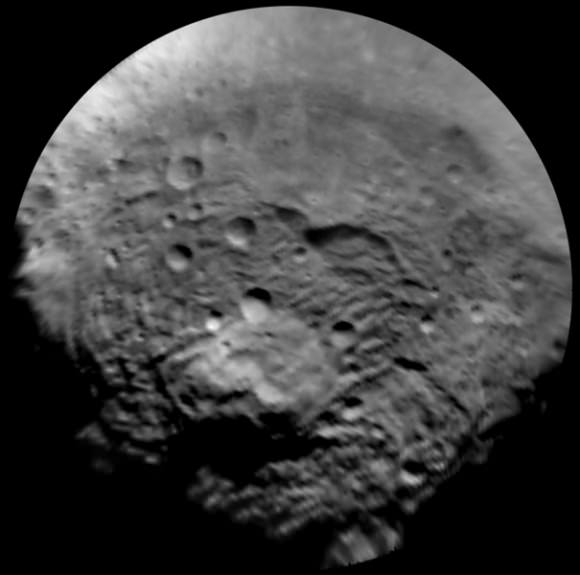
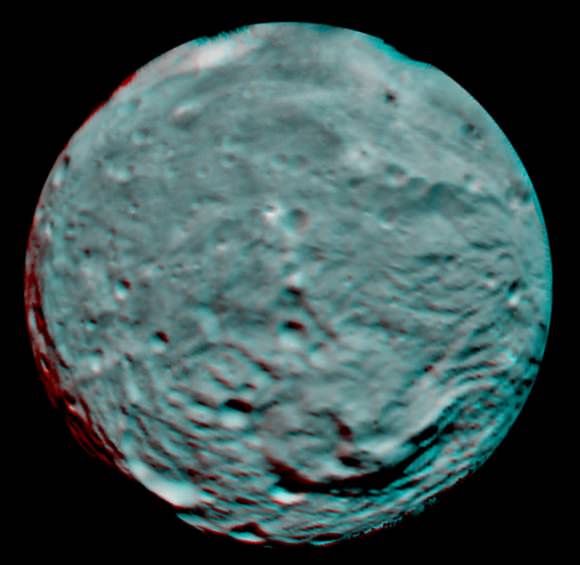
This anaglyph image of the south polar region of the asteroid Vesta was put together from two clear filter images, taken on July 9, 2011 by the framing camera instrument aboard NASA's Dawn spacecraft. Each pixel in this image corresponds to roughly 2.2 miles (3.5 kilometers). The anaglyph image shows the rough topography in the south polar area, the large mountain, impact craters, grooves, and steep scarps in three dimensions. The diameter of Vesta is about 330 miles (530 kilometers). Use red-green (or red-blue) glasses to view in 3-D. NASA/JPL-Caltech/UCLA/MPS/DLR/IDA
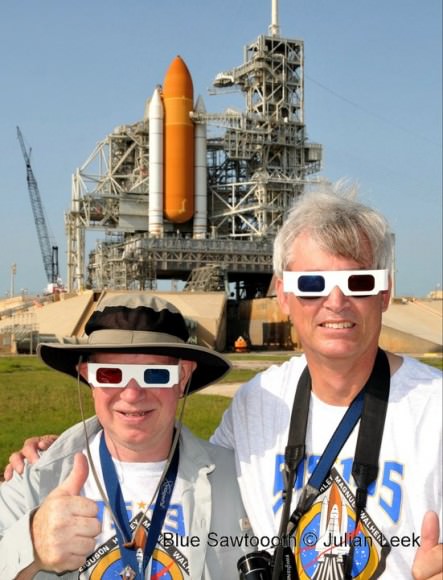
STS-135 twins show the right and wrong way to wear nifty 3-D glasses. Remember; red on the left (Ken Kremer – at right & Mike Barrett – at left, wrong) – backdropped by Space Shuttle Atlantis at the base of Launch Pad 39A at the Kennedy Space Center. Credit: Julian Leek
Read my prior features about Dawn
Dawn Exceeds Wildest Expectations as First Ever Spacecraft to Orbit a Protoplanet – Vesta
Dawn Closing in on Asteroid Vesta as Views Exceed Hubble
Dawn Begins Approach to Asteroid Vesta and Snaps First Images
Revolutionary Dawn Closing in on Asteroid Vesta with Opened Eyes
ULA Inks Deal With NASA To Study Man-Rating Atlas V
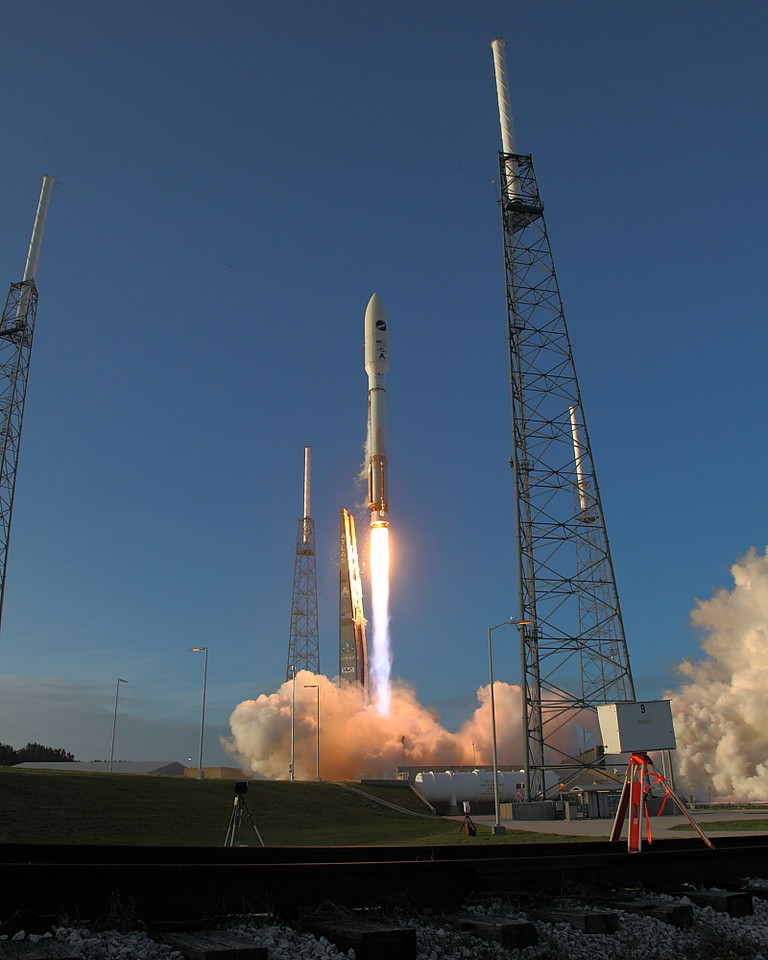
[/caption]
CAPE CANAVERAL Fla. — NASA is looking for a few good rockets – that’s right, plural. While it continues to review the Space Launch System or SLS – it has inked a non-funded agreement with United Launch Alliance (ULA) to utilize the Denver-based firm’s Atlas V rockets to send astronauts into orbit. The announcement was made at Kennedy Space Center in Florida on Monday.
The Space Act Agreement signed by the space agency and ULA will see critical information regarding the flight characteristics of the Atlas V be provided to NASA. ULA will not be alone in providing information however; NASA will give ULA vital data regarding its experience sending humans into orbit as well as guidance as how to adapt the Atlas V for human space flight purposes. NASA will help ULA with both the crew transportation system capabilities as well as the human certification requirements.
This will begin a process where ULA and NASA will work closely with one another to guide the Atlas V toward being man-rated. Before that can happen there are numerous pertinent issues that have to be reviewed first, such as the cost involved and other issues involved with the certification process.
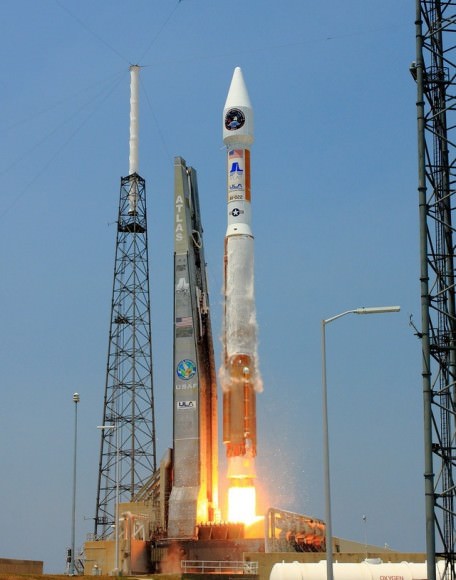
The Atlas V is an expendable launch vehicle that has not only been used by NASA, but the Department of Defense (DoD) as well. The Atlas’ proven track record should allow a large portion of the study to be completed before the end of this year.
NASA’s part of the arrangement includes providing milestone briefings and technical reviews to check and see how the project is progressing as well as identifying risks and attempting to mitigate them.
ULA meanwhile will use its own funds to pay for the Crew Transportation System (CTS). Design maturation, required analyses (including hazard reviews that are unique to human space flight efforts) as well as establishing a man-rated baseline for the Atlas V all will be handled by United Launch Alliance.
The rationale behind why the Atlas V was specifically selected is simple, both Sierra Nevada Corporation and Blue Origin’s proposals under the Commercial Crew Development – 02 (CCDev-02) contract – utilize the Atlas V. Bigelow Aerospace has also looked at the rocket as a launch service provider.
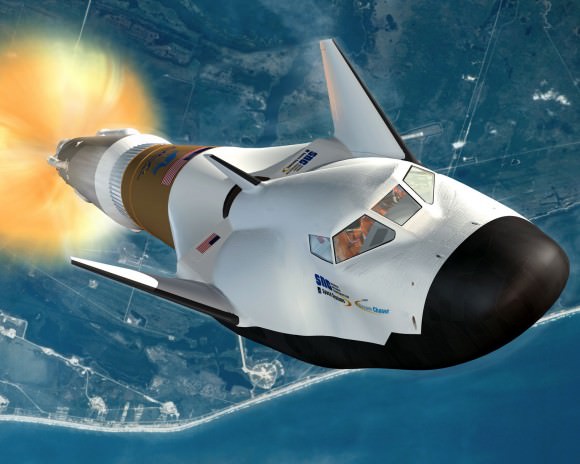
“I am truly excited about the addition of ULA to NASA’s Commercial Crew development Program team,” said NASA Administrator Charles Bolden. “Having ULA on board may speed the development of a commercial crew transportation system for the International Space Station, allowing NASA to concentrate its resources on exploring beyond low
Earth orbit.”
The Atlas V has had 26 consecutive successful flights, making it an easily one of the front runners to potentially send astronauts to orbit.
“We believe this effort will demonstrate to NASA that our systems are fully compliant with NASA requirements for human spaceflight,” said George Sowers, ULA’s vice president of business development. “ULA looks forward to continued work with NASA to develop a U.S. commercial crew space transportation capability providing safe,
reliable, and cost effective access to and return from low Earth orbit and the International Space Station.”
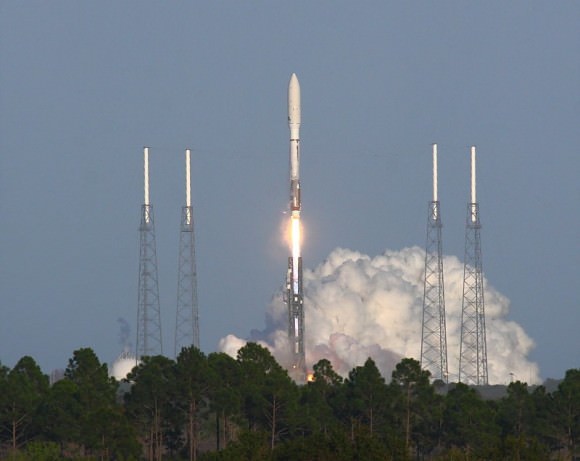
One on One with SpaceX’s Garrett Reisman
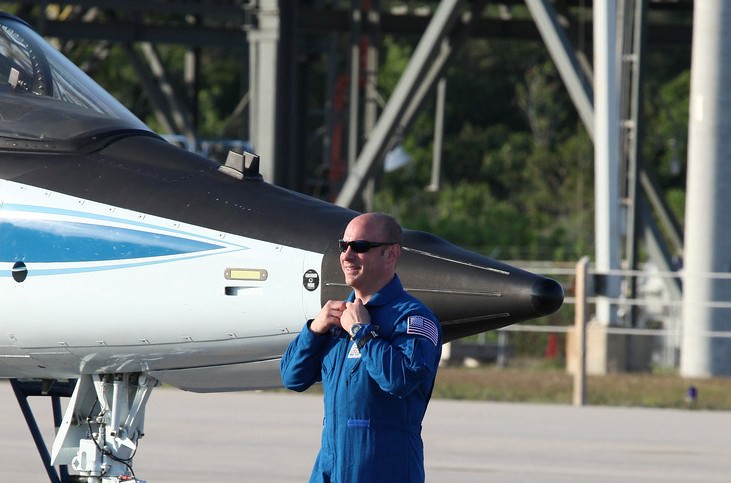
[/caption]
CAPE CANAVERAL Fla. – Garrett Reisman knows a thing or two about what it takes to send astronauts to orbit. He should, he has taken the trip himself – twice. Reisman spent three months on the International Space Station launching with the STS-123 crew, and was a Mission Specialist on STS-132. He has walked in space, operated Canada’s Dextre robot and installed critical flight hardware to the ISS.
He has since left NASA to work for Space Exploration Technologies (SpaceX). Reisman took a moment to chat with Universe Today just before the final launch of the shuttle program, STS-135, on the orbiter Atlantis. Reisman spoke about SpaceX’s contract with NASA under the second phase of the Commercial Crew Development contract or CCDev-02, his new role as Director of SpaceX’s Dragon Rider program and whether there is another trip to space in his future.
Universe Today: Hi Garrett, thanks for taking the time to talk with us today, tell us a little about CCDev-02.
Reisman: “Thanks, it’s good to be here, SpaceX has dubbed CCDev-02 the ‘Dragon Rider’ program, CCDev sounds like someone’s logon name. Dragon Rider is the name of SpaceX’s efforts to send astronauts into orbit on board the Dragon Spacecraft.”
Universe Today: A nod to Anne McCaffrey’s Dragonriders of Pern?
Reisman: “Exactly!” (laughing)
Universe Today: If you had to pick out one of the most interesting elements of what SpaceX is working on for CCDev-02 – what would it be?
Reisman: “I think I would have to say it is the integrated launch abort system. The system that SpaceX is working on will not be the normal tower that is positioned above the spacecraft; instead it will be built into the sides of the Dragon. This system will be reusable and allow the Dragon to land.”
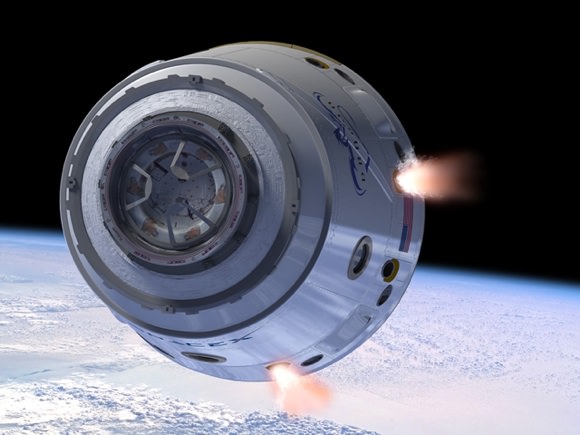
Universe Today: What do you think sets SpaceX apart from other, similar companies?
Reisman: “Some companies will offer you the rocket, others the spacecraft, at SpaceX we got both – it’s one-stop-shopping. We got the rocket, the Falcon 9, which has had two very successful test flights and we have the Dragon Spacecraft which became the first commercial spacecraft to orbit the Earth and splash down safely this past December. With both of these vital elements we have great confidence that we can do what we say we will do as we move forward.”
Universe Today: What made you decide to leave NASA and come to SpaceX?
Reisman: “I left NASA about four months ago and came over to SpaceX because I was very excited about what was going on in the commercial sector, just all this amazing innovation that was being unleashed and I wanted to be a part of that, to contribute to that.”
Universe Today: Final question, as a veteran astronaut are you hoping to ride Dragon to orbit one day?
Reisman: (smiles) While that’s not why I joined SpaceX – I wouldn’t rule it out either…”
SpaceX is looking to launch the next Falcon 9 rocket with Dragon Spacecraft some time this fall from Cape Canaveral Air Force Station’s Launch Complex 40. This demonstration flight will test out the Dragon’s navigation and other operating systems. This year SpaceX is planning to launch two flights under the Commercial Orbital Transportation Services or COTS contract, worth $1.6 billion, that the company has with NASA.
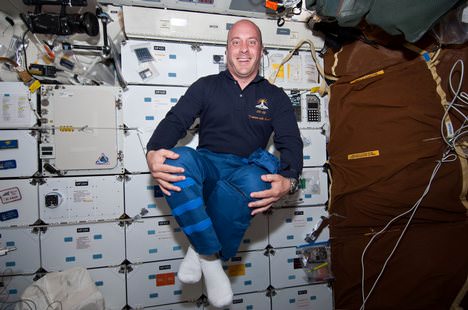
Dawn Exceeds Wildest Expectations as First Ever Spacecraft to Orbit a Protoplanet – Vesta
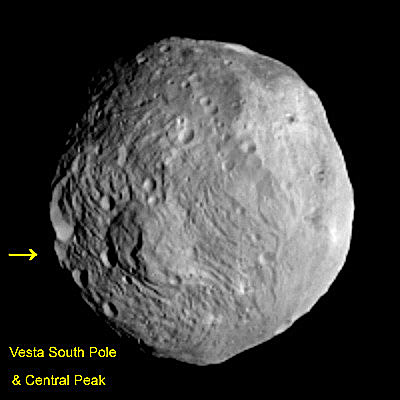
[/caption]
NASA’s super exciting Dawn mission to the Asteroid Belt marked a major milestone in human history by becoming the first ever spacecraft from Planet Earth to achieve orbit around a Protoplanet – Vesta – on July 16. Dawn was launched in September 2007 and was 117 million miles (188 million km) distant from Earth as it was captured by Asteroid Vesta.
Dawn’s achievements thus far have already exceeded the wildest expectations of the science and engineering teams, and the adventure has only just begun ! – so say Dawn’s Science Principal Investigator Prof. Chris Russell, Chief Engineer Dr. Marc Rayman (think Scotty !) and NASA’s Planetary Science Director Jim Green in exclusive new interviews with Universe Today.
As you read these words, Dawn is steadily unveiling new Vesta vistas never before seen by a human being – and in ever higher resolution. And it’s only made possible via the revolutionary and exotic ion propulsion thrusters propelling Dawn through space (think Star Trek !). That’s what NASA, science and space exploration are all about.
“Dawn is in orbit, remains in good health and is continuing to perform all of its functions,” Marc Rayman of the Jet Propulsion Laboratory, Pasadena, Calif., told me. “Indeed, that is how we know it achieved orbit. The confirmation received in a routine communications session that it has continued thrusting is all we needed.”
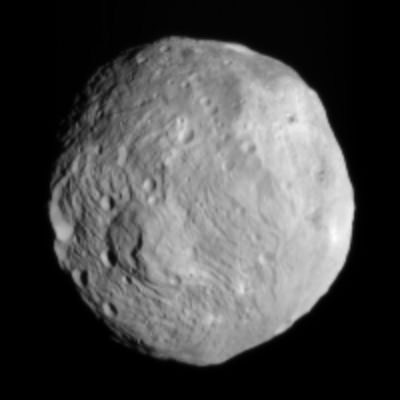
Dawn entered orbit at about 9900 miles (16000 km) altitude after a nearly 4 year journey of 1.73 billion miles.
Over the next few weeks, the spacecrafts primary task is to gradually spiral down to its initial science operations orbit, approximately 1700 miles above the pock marked surface.
Vesta is the second most massive object in the main Asteroid Belt between Mars and Jupiter. Dawn is the first probe to orbit an object in the Asteroid Belt.
I asked Principal Investigator Chris Russell from UCLA for a status update on Dawn and to describe what the team can conclude from the images and data collected thus far.
“The Dawn team is really, really excited right now,” Russell replied.
“This is what we have been planning now for over a decade and to finally be in orbit around our first ‘protoplanet’ is fantastic.”
“The images exceed my wildest dreams. The terrain both shows the stress on the Vestan surface exerted by 4.5 billion years of collisions while preserving evidence [it seems] of what may be internal processes. The result is a complex surface that is very interesting and should be very scientifically productive.”
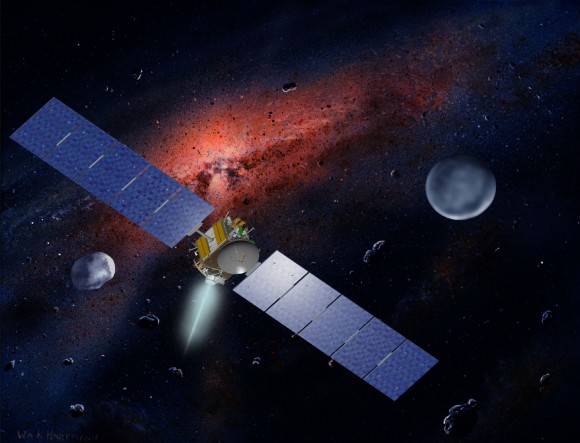
“The team is looking at our low resolution images and trying to make preliminary assessments but the final answers await the higher resolution data that is still to come.”
Russell praised the team and described how well the spacecraft was operating.
“The flight team has been great on this project and deserves a lot of credit for getting us to Vesta EARLY and giving us much more observation time than we had planned,” Russell told me.
“And they have kept the spacecraft healthy and the instruments safe. Now we are ready to work in earnest on our science observations.”
Dawn will remain in orbit at Vesta for one year. Then it will fire its ion thrusters and head for the Dwarf Planet Ceres – the largest object in the Asteroid Belt. Dawn will then achieve another major milestone and become the first spacecraft ever to orbit two celestial objects.
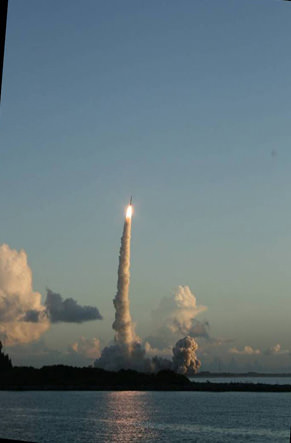
Jim Green, Director of Planetary Science for the Science Mission Directorate (SMD) at NASA HQ in Washington, DC, summed up his feelings about Dawn in this way;
“Getting Dawn into orbit is an amazing achievement,” Green told me.
“Instead of the ‘fire the thrusters full blast’ we just sort of slid into orbit letting gravity grab the spacecraft with a light tug. This gives us great confidence that the big challenge down the road of getting into orbit around Ceres can also be accomplished just as easily.”
Sharper new images from Vesta will be published by NASA in the next day or so.
“We did take a few navigation images in this last sequence and when they get through processing they should be put on the web this week,” Russell informed. “These images are from a similar angle to the last set and with somewhat better resolution and will not reveal much new.”
However, since Dawn is now orbiting Vesta our upcoming view of the protoplanet will be quite different from what we’ve seen in the approach images thus far.
“We will be changing views in the future as the spacecraft begins to climb into its science orbit,” stated Russell.
“This may reveal new features on the surface as well as giving us better resolution. So stay tuned.”
Marc Rayman explained how and why Dawn’s trajectory is changing from equatorial to polar:
“Now that we are close enough to Vesta for its gravity to cause a significant curvature in the trajectory, our view is beginning to change,” said Rayman. “That will be evident in the pictures taken now and in the near future, as the spacecraft arcs north over the dark side and then orbits back to the south over the illuminated side.”
“The sun is over the southern hemisphere right now,” added Russell. “When we leave we are hoping to see it shine in the north.”
Dawn is an international mission with significant participation from Germany and Italy. The navigation images were taken by Dawn’s framing cameras which were built in Germany.
Exploring Vesta is like studying a fossil from the distant past that will immeasurably increase our knowledge of the beginnings of our solar system and how it evolved over time.
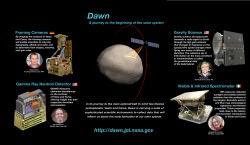
Vesta suffered a cosmic collision at the south pole in the distant past that Dawn can now study at close range.
“For now we are viewing a fantastic asteroid, seeing it up close as we zero in on its southern hemisphere, looking at the huge central peak, and wondering how it got there,” explained Jim Green
“We know Vesta was nearly spherical at one time. Then a collision in its southern hemisphere occurred blowing off an enormous amount of material where a central peak now remains.”
That intriguing peak is now obvious in the latest Dawn images from Vesta. But what does it mean and reveal ?
“We wonder what is that peak? replied Green. “Is it part of the core exposed?
“Was it formed as a result of the impact or did it arise from volcanic action?”
“The Dawn team hopes to answer these questions. I can’t wait!” Green told me.
As a result of that ancient south pole collision, about 5% of all the meteorites found on Earth actually originate from Vesta.
Keep your eyes glued to Dawn as mysterious Vesta’s alluring secrets are unveiled.
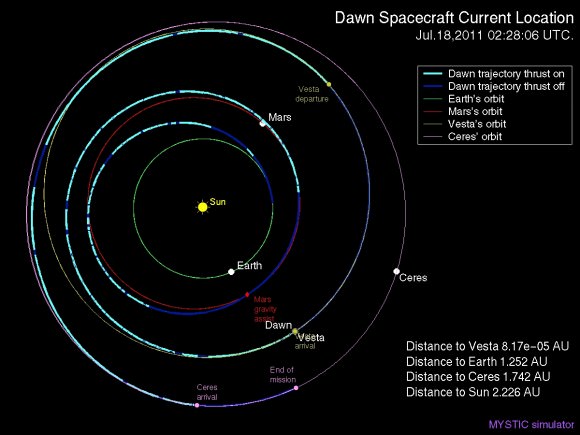
Read my prior features about Dawn
Dawn Closing in on Asteroid Vesta as Views Exceed Hubble
Revolutionary Dawn Closing in on Asteroid Vesta with Opened Eyes
Two Days of Tweetness: Witnessing a Shuttle Launch
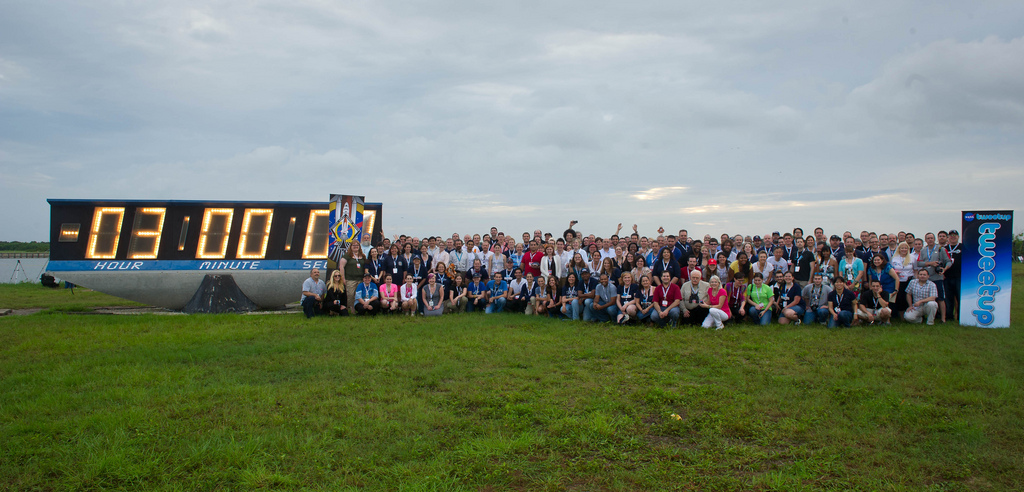
It’s been over a week since the NASA Tweetup and I’m still thinking about it. For good reason, of course… it was awesome.
Over the course of two days I saw a capsule that had been to space and back, talked with five astronauts (one currently in orbit!), toured Kennedy Space Center, met a muppet, touched a piece of the Moon, made dozens of new friends and, of course, watched, heard and felt the launch of the last space shuttle to leave Earth. (And managed to talk my way into a delicious barbecue sandwich inside the Vehicle Assembly Building.) All with less than six hours of sleep.
Not too shabby. 😉
Continue reading “Two Days of Tweetness: Witnessing a Shuttle Launch”
Revolutionary Robotic Refueling Experiment Opens New Research Avenues at Space Station
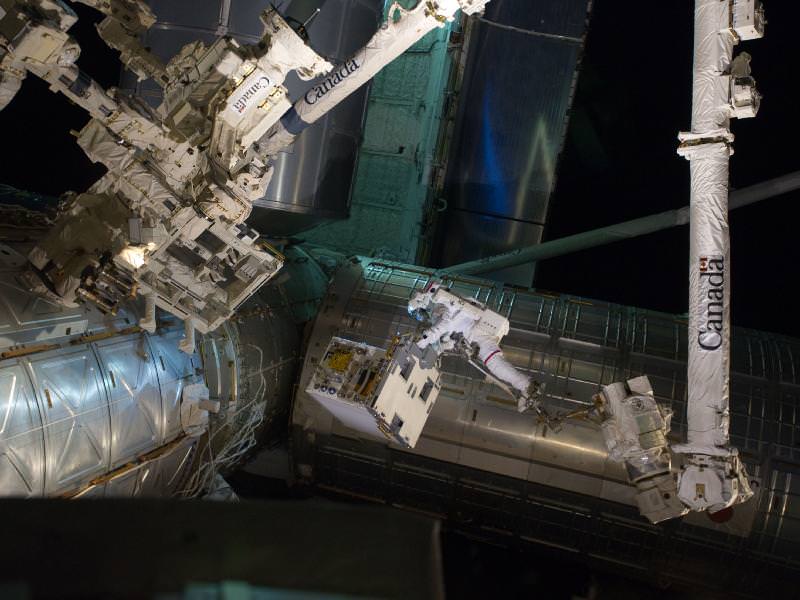
[/caption]
NASA’s new Robotic Refueling Experiment (RRM) is a revolutionary technology demonstration device – brought aloft by the final shuttle mission – that will test out and prove whether existing Earth orbiting spacecraft that were never intended to be serviced can be successfully refueled and repaired robotically.
The RRM payload is a state of the art path finding experiment that promises to open exciting new avenues of station science research that potentially could save and extend the lifetime of orbiting commercial, government and military satellites valued at billions of dollars.
RRM was delivered to the International Space Station (ISS) by the four person crew of STS-135, the shuttles grand finale. The project is a joint effort between NASA and the Canadian Space Agency (CSA).
During the very final spacewalk of the Space Shuttle Era, RRM was temporarily installed by US astronauts Mike Fossum and Ron Garan onto a platform on the Dextre robot – the Special Purpose Dexterous Manipulator – which functions as a “handyman” in space.
Dextre is a two armed robot provided by CSA which is also a key component of the experiment because it enables the performance of repair and maintenance tasks at the heart of the RRM experiment.
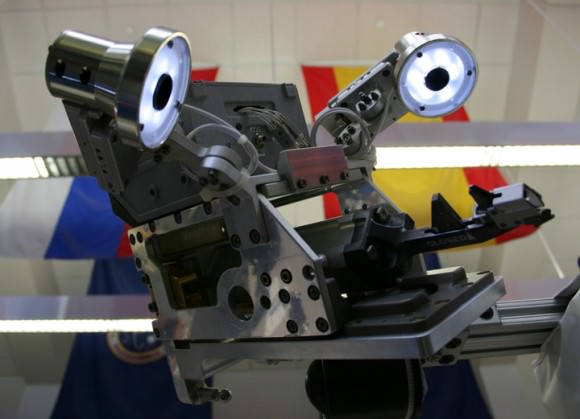
The washing machine sized unit weighs 500 pounds and was tucked inside the payload bay of Space Shuttle Atlantis and attached to the Lightweight Multipurpose Carrier (LMC) for the one way trip to space.
After Atlantis departs, RRM will be transferred to a permanent attach point on the stations truss and mounted on the Exterior Logistics Carrier 4 (ELC-4) of the million pound orbiting outpost.
RRM is NASA’s first ever such technology demonstration intended to test the feasibility of on orbit servicing operations on satellites that were not built to ever be worked upon and maintained after blasting off to space, according to Justin Cassidy, RRM Hardware Manager at the NASA Goddard Spaceflight Center in Greenbelt, Maryland.
The RRM box will simulate both the satellite to be serviced and the maintenance techniques required to perform both robotic refueling and repair work.
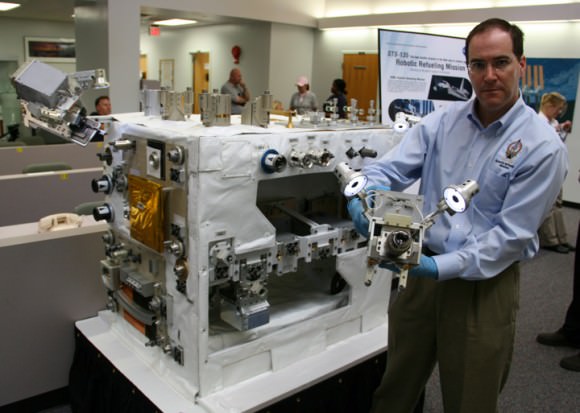
Equipment Tool movements and manipulations by Dextre robot are simulated by NASA Goddard RRM manager Justin Cassidy. Credit: Ken Kremer
“The Dextre robot will manipulate four specially designed ‘Tools’ stored in bays inside the RRM,” said Cassidy in an interview at the Kennedy Space Center.
Using a high fidelity RRM mockup – nicknamed ‘Rosie’ – on display at the Kennedy Space Center Press Site, Cassidy spoke to me in detail about the RRM mission and objectives.
The four unique RRM tools have heritage in the Hubble Servicing Missions and were developed at NASA Goddard; The Wire Cutter and Blanket Manipulation Tool, The Multifunction Tool, the Safety Cap Removal Tool, and the Nozzle Tool.
“Dextre will grapple the tools and move them around with its ‘hands’ to perform refueling and maintenance tasks on activity boards and simulated satellite components mounted on the exterior walls of the RRM,” Cassidy told me. “The activity boards can be swapped in the future to carry out new experiments.”
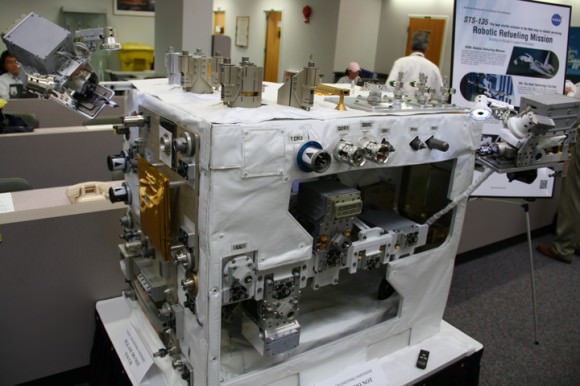
The RRM assignment marks the first use of Dextre beyond routine maintenance chores aboard the ISS. Indeed, the research project working with RRM is actually a new R & D function beyond what was originally planned and envisioned for Dextre, said Mathieu Caron, CSA Mission Operations manager.
Tasks planned for RRM include working on and manipulating caps, valves and screws of assorted shapes and sizes, cutting wires, adjusting thermal blankets and transferring fluids around fuel reservoirs. Ethanol will be used to simulate the flow of hydrazine fuel, said Cassidy.
“RRM will be operated by controllers on the ground at NASA Goddard, the Marshall Space Flight Center in Huntsville, Ala., and also in Canada by the Canadian Space Agency,” explained Cassidy.
Each RRM tool is equipped with integral cameras housing six built in LED’s to aid ground controllers precisely guide the tools.
“The RRM experiment phase to demonstrate robotic refueling and maintenance operations at the ISS is set to last two years and could continue for perhaps ten or more years,” said Cassidy.
President Obama asked the STS-135 crew about the RRM experiment during an Oval Office phone call from the White House to the ISS. Watch Obama’s phone call on YouTube
NASA hopes that the small investment in RRM technology demonstration will pave the way for advanced follow missions and private development of commercial robotic refueling and maintenance vehicles – in the not too distant future – that will reap billions of dollars in cost savings and dividends.
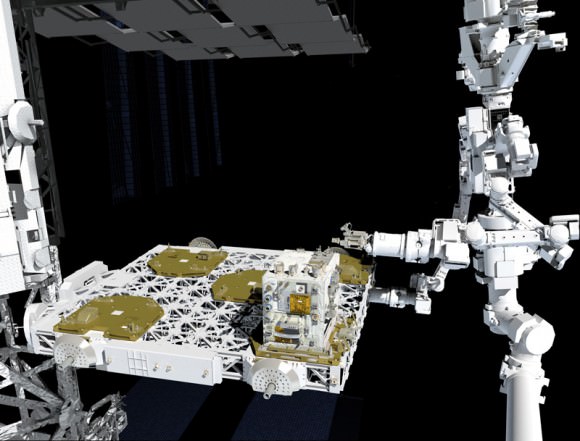
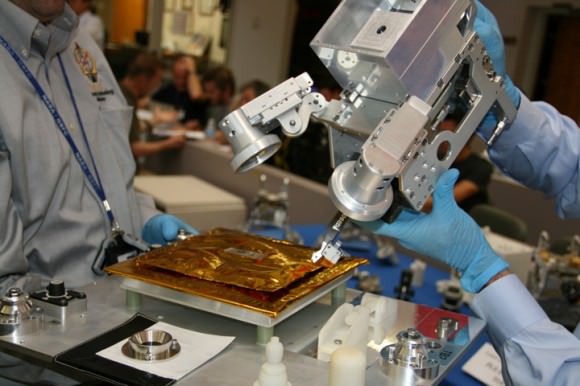
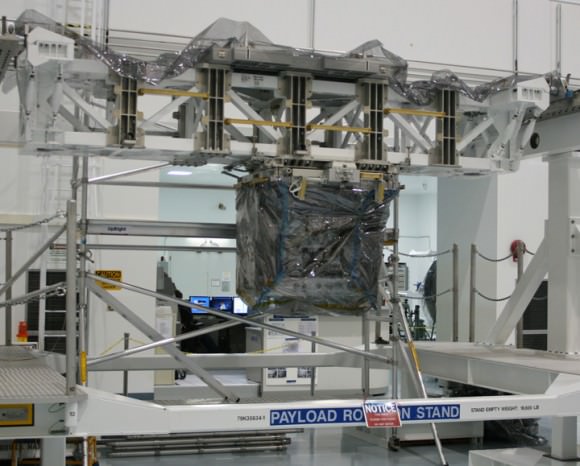
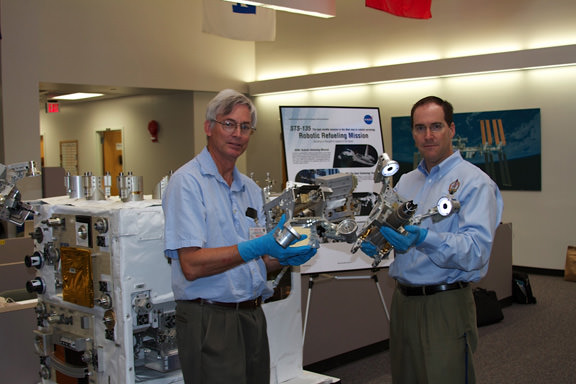
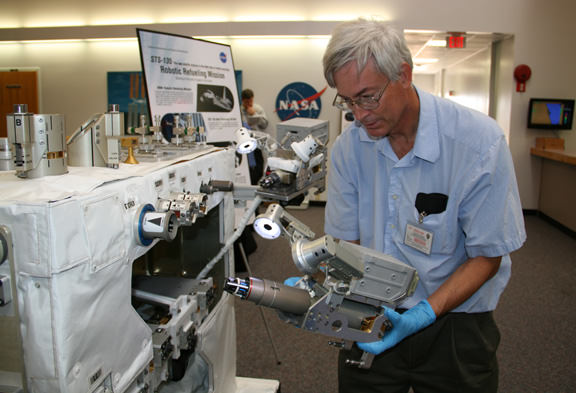
Read my features about the Final Shuttle mission, STS-135:
Water Cannon Salute trumpets recovery of Last Shuttle Solid Rocket Boosters – Photo Album
Shuttle Atlantis Soars to Space One Last time: Photo Album
Atlantis Unveiled for Historic Final Flight amidst Stormy Weather
Counting down to the Last Shuttle; Stormy weather projected
Atlantis Crew Jets to Florida on Independence Day for Final Shuttle Blastoff
NASA Sets July 8 for Mandatory Space Shuttle Grand Finale
Final Shuttle Voyagers Conduct Countdown Practice at Florida Launch Pad
Final Payload for Final Shuttle Flight Delivered to the Launch Pad
Last Ever Shuttle Journeys out to the Launch Pad; Photo Gallery
Atlantis Goes Vertical for the Last Time
Atlantis Rolls to Vehicle Assembly Building with Final Space Shuttle Crew for July 8 Blastoff
